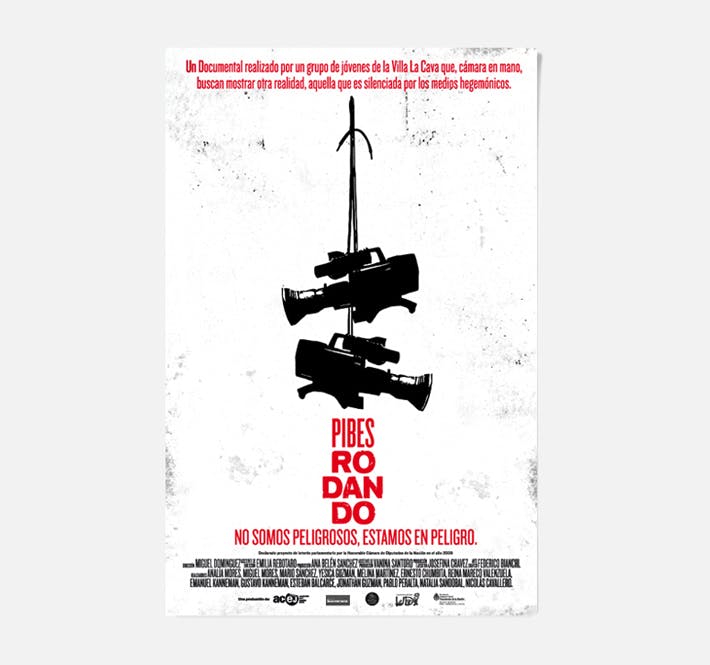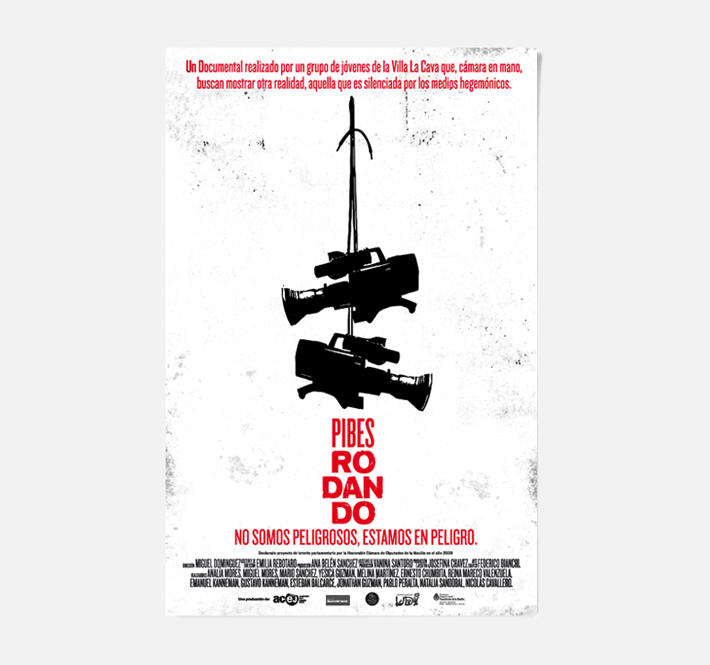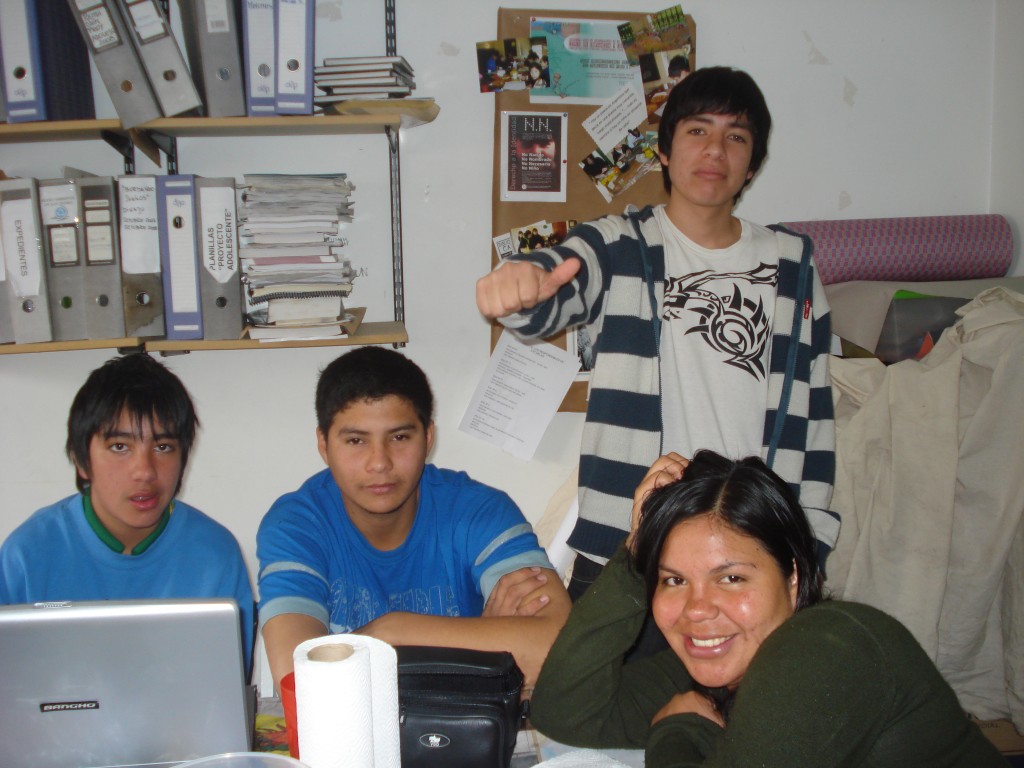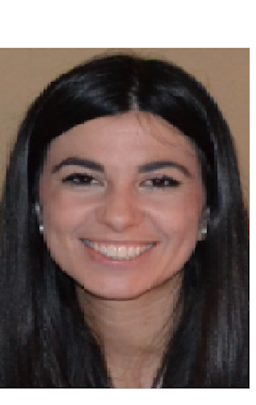Rolling guys: we are not dangerous, we are in danger. Youth conquest of rights, participation and film experience
Jan 21, 2015
First story





Between 2008 and 2012 a group of teenagers, led by women, decided to tell his true reality and your community through the use of digital tools.
I had the honor to accompany these young people during these years of communicational, digital and community empowerment. Through of ACEJ help them get technical resources to build a documentary film that would tell the reality of their lives. These teens live in one of the poorest neighborhoods of Buenos Aires and they needed to build a film story to represent them. This story was very different to what the mass media communicate daily. The medias linking youths to crime and delinquency.
Before extreme poverty, after deep socio-economic crisis of 2001, five NGOs, a public school and a network of academics, we got together to develop adhonorem, artistic, educational and sports workshops to over 120 children and young people in “La Cava”, the largest slum and shanty town of Buenos Aires. We also offer breakfast and lunch. This began in 2003 and continued until 2011.
In 2007, we began to offer a journalism workshop and new communication technologies. It was here, from the need of young people to express themselves, born kids rolling, we are non-hazardous, we're in danger. This time they begin to play in media mass speeches discriminatory against children and poor young people. In the media it related to all children and young poor as dangerous and criminals.
The adolescents and young people of the slum called “la Cava”, decide to make a film to tell the reality that comes out in the media. They actively doing the entire process of construction of the film: training in audiovisual tools, training in rights, research, script, production, editing and dissemination. This cinema experience is also policy because these young people become political reality actors to build his own speech, promoting a rights perspective.
Among the purposes: visibility of a vulnerable situation, leadership and community, political, social, educational and communicational empowerment of young people, promoting participation, training in communication tools and freedom of expression. All these purposes have not only been achieved with success but that in addition to having achieved a valuable and beautiful film in cinematic terms, has been replicated in other communities and in all the Argentina experience.
SITUATION BEFORE THE START OF THE INITIATIVE
2001: historical crisis in Argentina. Half of the poor were children/young people. Multiple poverty: not only unmet basic needs but that children and poor youth does not guarantee rights and sociocultural participation.
In “La Cava”, poverty reaches 15,000 families living in front of the country's richest sectors. Inequality and discrimination.
PRIORITIES
Twenty teenagers and young people from the Cava do a democratic vote to choose the way to claim their rights and tell how they live. Some vote make a festival. Making a documentary film receives more votes. For:
• Talk about rights that do not have to be poor. Make visible their reality.
• Tell that not all young poor people are criminals. They mark a tension with the pejorative representation made by means of poor youth.
• Become protagonists. They want to build throughout the film in training: screenplay, technique, research, editing, dissemination. Pre vocational training and occupational inclusion.
• Investigate and articulate laws and policies on children and youth.
Objective Strategy
Training professional pre in communicational tolos Request technical transfer to the Universidad de Buenos Aires. Civic awareness among young people.
Construction of movie that concientice on the violation of rights of young people. Prominence and youth leadership in construction of the film and the story. Analía Mores leads the group.
Articulation with national and provincial policies. Presentation of draft and request for subsidies before State, educational and private bodies. Apply for political support.
Articulation and incidence with laws Research and interviews of young people with judges. Comparison with the International Declaration on the rights of the child
PROCESS
Lack of confidence in being able to achieve a documentary. The leadership of Analía managed to empower the group with motives, goals and priorities. They succeeded in generating the idea that not only documentary was important for them but for all communities of poor young people who do not have social, educational opportunities, labour and political participation. "We must fight for our rights." "We are the voice of all".
Disorganization. ACEJ provided strategic planning. It provided technical team and a director.
Ignorance theoretical and technical. For youth initiative, ACEJ asked the University, URKO and the U.S. Embassy technical, theoretical training and technology.
Lack of economic resources. Young wrote a draft presented at State agencies making transfers.
Little community support. Analía and Melina led talks on rights in “la Cava”. The community adopted unanimously to be represented.
Speeches media loaded with discrimination against the poor young people. Young people manage to install the idea of that insecurity is not carry poor young people but the situation of poverty and lack of opportunities and rights.
Lack of political support. Young people held meetings with legislators and judges. They do statements of interest and political support. They are chosen as best practice 2009 and nominated for the International Festival of cinema politician.
Youth participation, is active led by Analía. Participated in the whole process of construction of the film. The contributions of young people have been technical manage audiovisual and ideological tools to be able to build a discourse on its reality and poverty. They resulted in the slogan: we are not dangerous, we are in danger. A call to attention to Argentine society. Young people were also trained in law. They studied the International Declaration on the rights of the child. 26.061 And 13.298 promotion and protection laws. They could detect living daily situations and called it as a violation of our rights. They were trained in communication law. An important national media law which we celebrate because it allows greater diversity and plurality of voices was enacted in 2009.
RESULTS ACHIEVED
Qualitative:
• Knowledge of the institutional mechanisms to apply for a grant. Training in law and new technologies. Management tools for planning and articulation.
• Childhood and communication laws were approved between 2007 and 2011. These changes are visibilizan in the film.
• Youth leadership in the community. Promote creation of Association of neighbors, girls, talks and debate in schools, criminal, dining rooms and parishes.
• Replica. Young people together with the Ministry of education agreed journey through the country. The axes to work: education, youth participation and citizenship.
• Youth and families feel that experience positively changed them life. They feel socially valued.
• The Group has boosted its recognition to the role of women in the community. A key factor has been the collective and democratic decision-making.
Quantitative:
• In 2011 in the network of social organizations for the right to education in North Park is the documentary before more than 500 young people.
• Training professional pre. 20 Young people were trained in audiovisual and technical tools. Job opportunities.
• In 2009 the mayor decides to lift a wall to separate a rich one poor neighborhood. Young people mobilize cameras and consciousness. This material is part of the film. Social activation stops the wall.
• Twenty youth empowered politically, led by a woman. “La Cava” of 15,000 families supported the film. Awareness and civic information. 10 adolescents returned to school.
SUSTAINABILITY
The process of construction of the film allowed elements of sustainability of the youth to mobilize 4-year civic education, community information, learning, access to the media world, legislative and educational. Greater community inclusion. They were presented as good practice in different festivals and State spaces. Some returned to school from the experience. They developed strategies of Community mobility and consciousness. Mobility and economic to receive training professional pre for labor inclusion. The majority wishes to pursue a career related to communication. Women were inserted in the project with equal opportunities than men. Young people have received economic scholarships.
Cultural sustainability lies in respect to his way of seeing the world, tell it, live it throughout the film. Their worldview. The processes of cultural discrimination living youth communities by some media and well-off sectors are strong.
Institutional sustainability: filming 2 fundamental laws of childhood that adapts to the International Declaration on the rights of the child were adopted and a national communication plurality Act. Young people participated in forums and spaces that promoted laws. And interviews with prestigious judges and journalists. PR outlined his ideas in the Parliament receiving technical and political support. Public policy (our place) and two ministries, took the experience of PR for your mirror in youth communities. North Park presents the documentary 500 young before. The documentary began as a youth demand, continued to be a process of actors and actions and finished deploying in a programme of action and replica. Financial sustainability: transparency and democracy in decision-making with regard to financial resources that juveniles had strengthened the project and the group.
LESSONS LEARNED
Formed an invaluable human group with values of respect, cooperation and solidarity. There are many experiences in film triggers that have contributed to the discussion on development, democracy and social inclusion of vulnerable communities. From Russian political cinema of the 1950s and critical Latin American cinema of the 1970s. Kids rolling must add in this type of experiences. Access, use and appropriation of media by social organizations or minorities, to allow the construction of an own discourse, allow the possibility of making visible the conflict, becoming subject citizens and conscious. Kids shooting, is the story of a particular experience of community organized and empowered through the use of the film. There is no doubt that the connectivity and access to training in digital tools improves the quality of life of communities.
The transformative and revolutionary nature of the construction of kids rolling process itself is a lesson as well as the possibility of the Group privilege the process above the same film. That process these youth were included in social, cultural and economically. Apart from the beautiful film, revolutionary of kids rolling lies in its process of building where many social actors and encouraging political context participated in the same. We are witnessing a community awareness through the filming; a decision of conscience that reverses in the Viewer. And convert an idea of young people in a public policy that is replicated throughout the country.




